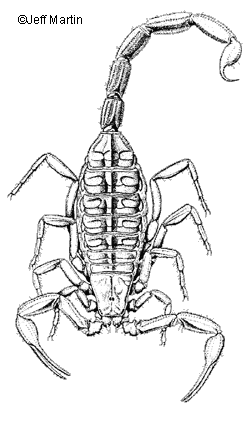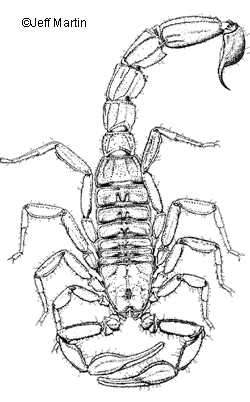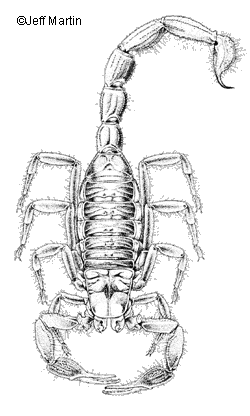Scorpions
Scorpions have changed little in the 350 to 400 million years since they first climbed from the primal seas and took their place among earth�s first terrestrial arthropods.
The long, segmented body of the scorpion is divided into two obvious sections: the elliptically shaped body and the trade-mark �tail.�The body of the scorpion is divided into two parts, the cephalothorax and the mesosoma or preabdomen. The cephalothorax contains all of the sensory, locomotion, and feeding appendages. Two pairs of chelicerae, positioned on either side of the mouth, allow the scorpion to rip and tear its prey while feeding. Combining the sensitivity of antennae with the grasping ability of a hand, the pedipalps (pincers) are used for sensing as well as holding prey while envenomating or eating. Male and female scorpions also use the pedipalps to clasp their mates during elaborate mating dances. Like all arachnids, scorpions have four pairs of jointed legs. Sensory hairs on the legs can detect the vibrations of prey up to 1 foot (30 cm) away. Dorsally the cephalothorax is covered by the carapace. A pair of median eyes atop the carapace, as well as several lateral eyes arranged into two groups along its front edge, give the animal its limited vision.
The mesosoma contains the paired genital openings, the spiracle slits that open into the tracheal system allowing the scorpion to breath, and the pectines, a pair of comb-like appendages on the ventral surface that sweep the ground possibly as contact pheromone detectors. The pectines may also help the male find a suitable place to deposit his spermatophore during mating.
|
|
| Class: Arachnida |
| Order: Scorpiones |
| Families: Buthidae, Diplocentridae, Iuridae, Superstitionidae, Vaejovidae |
| Arizona Upland genera: Hadrurus, Vaejovis, Centruruoides, Superstitionia |
| Spanish name: alacran |
|
|
The metasoma (tail) of the scorpion is actually an extension of the abdomen. It consists of five segments, each one longer than the last; at the tip is the telson (stinger), which is not considered a true segment.
 |
A scorpion uses its venomous sting primarily to subdue insect prey. It also uses the sting defensively, readily stinging a predator or the mistakenly placed bare foot.
Three species of scorpions are commonly found in the Arizona Upland subdivision of the Sonoran Desert. They are the bark scorpion, Centruroides exilicauda, the striped tail or devil�s scorpion, Vaejovis spinigerus, and the giant or desert hairy scorpion, Hadrurus arizonensis.
Although more than 30 species of scorpions are found in Arizona, only the sting of the bark scorpion is considered to be truly life threatening. Its slender shape, and its long, delicate pincers and tail distinguish it from other more stoutly-built species in the state. Of the three most commonly seen species, the bark scorpion is the only one that prefers to climb, and it may be found many feet above the ground on trees and rock faces. Because bark scorpions display negative geotaxis, that is they orient themselves upside down, people are often stung by them as they pick up an object and press against a scorpion clinging to the underside. Defensive stinging is usually a series of quick jabs, after which the scorpion makes a hasty retreat.
Its preference for climbing and natural attraction to cool moist areas and air flows makes C. exilicauda a frequent urban guest. Inside the house, scorpions may be seen trapped in sinks and bathtubs or hiding in dark areas of the closet or storage room. They may also be found climbing walls or clinging to the ceiling. Outside, Centruroides exilicauda frequently lives in lumber or brick piles. The only species tolerant of others, bark scorpions may be found in large aggregations, especially during their winter hibernation. Bark scorpions live in Baja California del Norte, northern Sonora, southeastern California, extreme southeastern Utah, Arizona and southwestern New Mexico.
 |
The stripe tailed scorpion is Arizona�s most common species of scorpion. This species occurs in a variety of habitats from near sea level to 7000 feet (2100 m) in Texas, New Mexico, Arizona, southern California, Sonora, and northeastern Baja California del Norte. These sturdy, medium-sized scorpions are usually under rocks during the day. Like all scorpions, they are nocturnal and venture from their shelters at night to forage for prey. A stout tail with darkly-marked ridges running lengthwise along the underside and a total body length of about 2 inches (5 cm) identify this most common desert ground dweller.
The giant hairy scorpion is one of the least common of Arizona�s desert scorpions and the largest scorpion in the United States (up to 6 inches [15 cm] long). It can be found at lower elevations in southern Utah, southern Nevada, southeastern California, Arizona, and northern Sonora. Its large size allows it to feed readily on other scorpions and a variety of other prey, including lizards. Burrowing deep in the desert soil, H. arizonensis often follows the moisture line. As summer progresses and the moisture level in the soil recedes, the scorpion follows it, creating burrows as deep as 8 feet (2.5 m) below the surface. A giant hairy scorpion frequently assumes a strong defensive posture when threatened, curling its body and tail high overhead and spreading its pincers. The stinging action is swift and well directed, but the sting is mild, causing only local pain and swelling.
Ecology
 |
While scorpions are well equipped for survival, they are not without their natural enemies. Scorpions not only feed upon each other but are prey to other animals as well. Elf Owls have been photographed bringing scorpions with their telsons removed to their young. Lizards and small fossorial snakes in the genera Chilomeniscus, Chionactis, and Sonora also find them suitable food. Grasshopper mice and desert shrews are known to feed on scorpions, as are pallid bats.
Scorpions give birth to live young through the summer months, frequently having retained sperm from mating the previous year before going into hibernation. Scorpions are not fully developed when they are born, and will continue to develop until the first molt of their exoskeleton in 7 to 21 days, depending on the species. As the babies are born, they quickly crawl up their mother�s pincers and legs to take a position on her back, where they will safely ride until they molt. Should they fall off, they can become prey�not only for a variety of arthropod predators, but also even for their mother.
One of the most fascinating things about scorpions is that they fluoresce under ultraviolet light, probably due to the complex substance in the epidermis that makes it impermeable. To truly appreciate the lives of scorpions, take a black light out to the desert on a warm, moonless night. You�ll be amazed at how common scorpions are in the undisturbed Arizona Upland habitat. You can also use this technique to observe these ancient nocturnal arachnids as they detect and capture prey, court and mate, and dig burrows. These behaviors are never seen when scorpions are encountered by turning over rocks and other materials where they spend the daylight hours. Not only can you find scorpions in nature using ultraviolet light, you can use this same technique to look for scorpions in and around your home.










